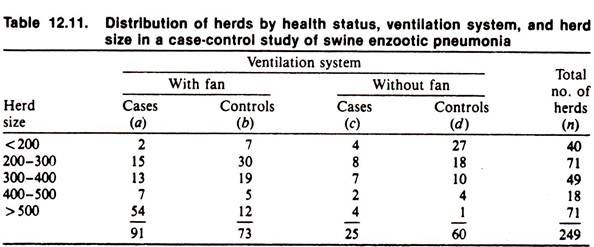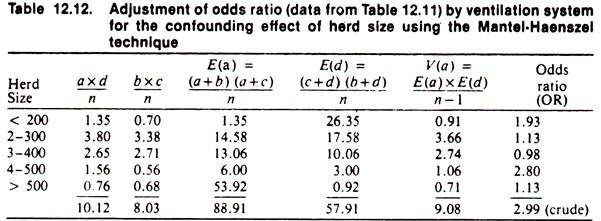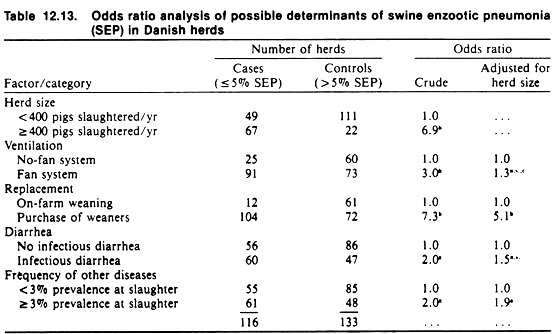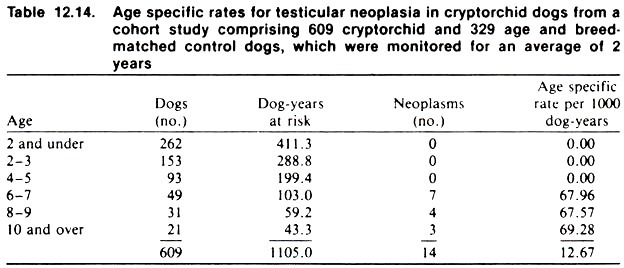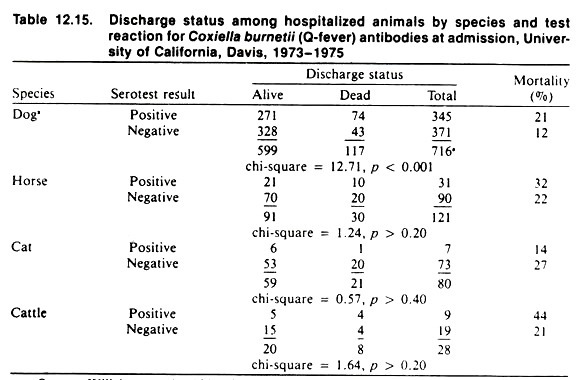In this article we will discuss about the analytic observational studies for animal disease etiology.
Case-Control Studies of Etiology:
The best way to make inferences about the etiology of a sporadic disease without accompanying data on the population base from which they originate is to perform a case-control study.
This approach is particularly well suited to cope with rare diseases. Case records may be retrieved from institutional files and a control group can be sampled from the same or other sources to represent the population distribution of the factor in question (e.g., age, breed, or sex).
Proper statistical comparisons can then be made (e.g., by the Mantel-Haenszel test) contrasting the characteristics of the cases with those of the control series to identify potential risk factors for the disease. Using this method it has been shown that Persian cats are at excess risk of FUS compared to domestic shorthair (Table 12.10) and that male and female dogs have the same risk of canine Cushing’s syndrome.
Both these examples are from studies based on the Veterinary Medical Data Program (VMDP), a system specifically designed to support case-control studies. The VMDP may therefore serve to indicate the possibilities and requirements in collecting data to study the epidemiology of sporadic animal diseases.
Veterinary Medical Data Program:
The Veterinary Medical Data Program (VMDP) was begun by the U.S. National Cancer Institute (NCI) in 1964, at the College of Veterinary Medicine, Michigan State University, to provide a reliable standardized source of data on disease in domestic animals. A number of veterinary schools in the United States and Canada have participated in this program.
At a collaborating veterinary college, when a patient is discharged or dies, the attending clinician completes a case summary form (or signs a summary form completed by the medical records specialist), including final diagnoses. The case summary, kept with the patient’s permanent record file, is used by the medical records specialist to complete a standard VMDP abstract for entry on magnetic tape.
ADVERTISEMENTS:
The unique identifying number assigned each patient and used whenever that patient returns to the clinic provides a means of subsequently determining how many different patients were seen in each age, breed, sex, or weight subcategory, as well as the diagnostic and/or operative characteristics of each subcategory.
In addition, the identifying number makes it possible to assemble a summary of the entire clinical history of an individual by computer, without manually referring to original medical records. (One limitation is that many of the institutions contributing to VMDP are referral institutions, and hence a patient may only be seen for particularly serious diseases because less serious diseases are handled by the client’s regular veterinarian.)
Diagnoses and operations entered into VMDP are assigned numeric codes from the Standard Nomenclature of Veterinary Diseases and Operations (1975) and its supplements.
The SNVDO codes are based on systematic numbering of:
ADVERTISEMENTS:
(1) All parts of the body,
(2) All etiologic agents, and
(3) All operative procedures.
Combinations are used to code diagnoses and operations. Standard codes for patient information (e.g., age, breed, sex, and weight) are provided on the abstract forms and in the VMDP Users Guide furnished participants.
The summary data on every patient, including diagnoses and operations, are entered on magnetic tape and sent to a central computing facility for storage and analyses. Quarterly tabulations sent to each participating school consist of listings of all cases arranged in numeric sequence according to several classifications such as patient’s case number, etiology, or topographic site and summaries of the number of cases in various demographic categories Each participating school also receives an annual tabulation of its own data, and, if requested, a tabulation made from the combined data submitted by all participants.
Combined annual reports for each year from 1968 are kept on file at NCI. From these, one can estimate the total of any diagnosis or operation reported to VMDP. While not useful alone in analytic studies these estimates can be of value as background material or in planning research projects.
Consisting of all discharges reported to VMDP since March 1964, the main magnetic tape data bank is available to all VMDP participants and other research groups. If the research will identify a particular school, permission must be sought before publication of results.
With more than 2 million records stored, the VMDP is the largest extant source of data on disease in domestic and pet animals. There have been more than 100 published reports to date based on analyses of these data, on topics as diverse as cancer, congenital heart disease, lead poisoning, endocrine diseases, and the feline urologic syndrome. Currently, the VMDP is being maintained by the College of Veterinary Medicine, Cornell University, Ithaca, New York.
Other sources of data:
ADVERTISEMENTS:
All practitioners use their experience and the most recent knowledge when diagnosing and treating cases of sporadic diseases. Yet in some instances, their performance would probably be improved if formal testing of their impressions were periodically carried out based on records from their own or neighbouring practices. At one time it was not atypical for practitioners to carry out surveys on their own clients for this purpose; unfortunately, this practice has declined in recent years.
Usually, the relevant information needed to test a particular causal hypothesis is not always in the case records. This is particularly true when investigating specific exposures, although the common attributes (host factors) are often routinely recorded. Thus, it may be necessary to collect supplementary data (e.g., by questionnaires sent to owners of affected animals and owners of a comparison group of control animals).
For example, several case-control studies of the role of dietary factors in the feline urologic syndrome (FUS) were carried out using records on FUS cases and selected control cats from clinics. In addition, mailed questionnaires were sent to cat owners inquiring about the composition of the diet.
In a similar manner, data on environmental and managerial factors at the herd level may be collected by personal interview or by questionnaires sent to owners of problem herds identified from routine diagnostic records (e.g., records kept in a practice, laboratory, or slaughterhouse) and to a sample of control herds.
For example, in a study of swine enzootic pneumonia, data on barn ventilation were collected by questionnaires, whereas herd size and disease prevalence were estimated from data in the Danish slaughterhouse system. These data are shown in Tables 12.11 and 12.12, and the procedure to calculate the summary odds ratio using the Mantel-Haenszel method is also demonstrated. Note that the crude odds ratio (not adjusted for herd size) is significant, whereas the adjusted odds ratio is not significant (Table 12.12).
The relationship of some other factors to enzootic pneumonia prevalence is shown in Table 12.13. As another example of this approach, a practitioner who had several herds with a high frequency of LDA in his district suspected feeding to be a contributory cause. Data on dietary composition were collected from a group of affected herds and from a selected group of non-affected herds of similar size and production from the same general area.
(The herds were matched on herd size, production, and locality.) The results (shown in Table 6.6) supported the idea that rations with low crude-fiber content were associated with increased occurrence of LDA.
Subsequently, the practitioner was in a much better position to advice on preventive measures against LDA. (Because the information is based on the farmer’s own data, acceptance of control programs may be increased over suggested control strategies based on less direct data.)
Similar examples of this approach are found in studies of factors associated with mastitis and factors associated with Haemophilus pleuropneumoniae in swine. Although subclinical mastitis is an endemic disease and clinical mastitis is sporadic, the methods used to study their epidemiologies are similar.
In the study of pneumonia in swine, questionnaires were sent to registered pork producers in an attempt to estimate the prevalence of the problem as well as to identify risk factors for the syndrome. The low response rate in the swine study (22.5%) and the differential in responses between case and control herds in the mastitis survey (49% versus 81%) indicate the need for caution when interpreting the results of these otherwise well-designed studies.
Cohort Studies of Etiology:
It is rare that data sets suitable for a cohort or longitudinal study of sporadic diseases are available. Although cohort studies have numerous advantages over case-control studies (including the ability to estimate incidence rates among exposed and unexposed individuals), the difficulties in carrying out such studies are numerous.
These include the long monitoring period of a large cohort to observe just a few cases, and the necessary tracing of the individuals during follow up makes it an expensive and tedious undertaking.
One of the cohort studies concerns testicular tumor development in cryptorchid versus intact dogs. Many of the problems just mentioned arose in this study. Veterinarians from 22 practices collaborated in the study, and there was a wide variation among practices in the number of cryptorchids identified.
This suggested either a difference in the at-risk population or variation in the interest of the practitioners. More than 25% of the dogs initially identified were lost to follow up during the 5- year study; often the owner could not be traced.
This loss was particularly great during the first year after diagnosis of the condition or selection for the control cohort. In total, almost 1000 dogs (609 cryptorchids) were monitored and only 14 of these developed testicular neoplasia (Table 12.14).
Despite the large effort, this was too few cases to provide valid estimates of breed specific rates. Another example of a cohort study involved a follow up of cats living in households with leukemic cats. The general feline population was used as the non-exposed group for purposes of comparison.
In one of the cohorts of exposed cats, over 500 cats were followed for several years; 41 developed leukemia of which 11 (27%) were classified as feline leukemia virus-negative. This percentage of virus-negative leukemic cats was higher than in the general population where the overall rates of leukemia were much lower.
Thus, the authors concluded that cats in households with feline leukemia virus excretors were at increased risk of leukemia whether virus was subsequently found in the new leukemia cases or not. This phenomenon of virus-negative leukemic cats is currently explained by the “immune-selection hypothesis”.
Cross-Sectional and Longitudinal Studies of Etiology:
Longitudinal studies have been applied in a few instances using data bases specifically designed to provide estimates of cancer incidence and distribution in dogs and cats. One example is the Animal Neoplasm Registry of the Alameda and Contra Costa counties of California.
In this program, all veterinary practices in a defined geographic area submit data and tissue specimens on all neoplastic conditions to a common pathology laboratory for diagnosis. To establish a reference population, questionnaire surveys (census) of the households in the area are taken repeatedly to estimate the size and characteristics of the population at risk.
A somewhat similar situation exists in Denmark, where since 1959 all cattle tumors have been deemed notifiable diseases and must be submitted for histopathology, whether as a biopsy from a clinical case or as tissue samples collected from abattoirs or from necropsies. Statistics are also being prepared on non-enzootic types of leukosis (juvenile, skin, and sporadic adult bovine leukosis).
Appropriate population figures from published yearly census reports are used in the conversion of the numerator data to rates. For example, between 1969 and 1980 the incidence rate of sporadic adult leukotic tumors decreased from 4 to 2 per 105 cow-years at risk, while the incidence rate of enzootic tumors dropped from 1.5 down to 0.15 per 105 cow-years at risk over the same period.
Cross-sectional studies can be conducted on hospitalized animals. Willeberg carried out a serological survey of Q-fever antibodies among hospitalized animals. This study indicated associations between seroreaction in dogs and their sex (data not shown) and discharge status, respectively (Table 12.15).
While sex may be regarded as a contributory factor to seropositive status, the discharge status may possibly be a result of the infection. It is more likely, however, that discharge status and seroreaction are partly determined by a third factor, namely the primary disease for which the dogs were hospitalized.
The latter explanation suggests either that dormant Q-fever infections are turned into active ones by various debilitating conditions, or weakened individuals are highly susceptible to a widespread Q-fever agent. This example again illustrates the kind of problems that one may get into in interpretation of results from cross-sectional surveys.

